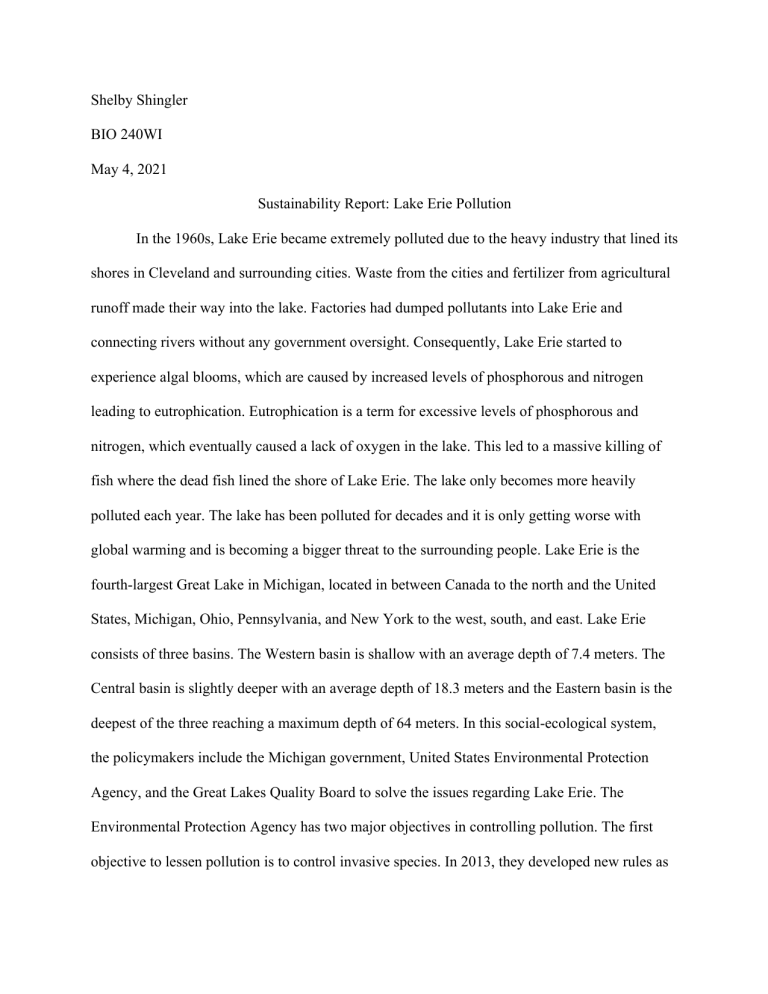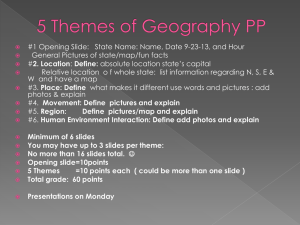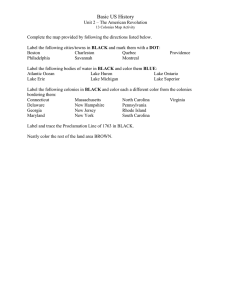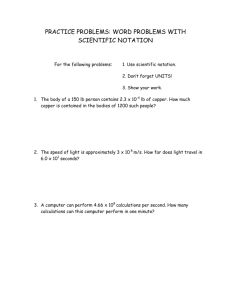
Shelby Shingler BIO 240WI May 4, 2021 Sustainability Report: Lake Erie Pollution In the 1960s, Lake Erie became extremely polluted due to the heavy industry that lined its shores in Cleveland and surrounding cities. Waste from the cities and fertilizer from agricultural runoff made their way into the lake. Factories had dumped pollutants into Lake Erie and connecting rivers without any government oversight. Consequently, Lake Erie started to experience algal blooms, which are caused by increased levels of phosphorous and nitrogen leading to eutrophication. Eutrophication is a term for excessive levels of phosphorous and nitrogen, which eventually caused a lack of oxygen in the lake. This led to a massive killing of fish where the dead fish lined the shore of Lake Erie. The lake only becomes more heavily polluted each year. The lake has been polluted for decades and it is only getting worse with global warming and is becoming a bigger threat to the surrounding people. Lake Erie is the fourth-largest Great Lake in Michigan, located in between Canada to the north and the United States, Michigan, Ohio, Pennsylvania, and New York to the west, south, and east. Lake Erie consists of three basins. The Western basin is shallow with an average depth of 7.4 meters. The Central basin is slightly deeper with an average depth of 18.3 meters and the Eastern basin is the deepest of the three reaching a maximum depth of 64 meters. In this social-ecological system, the policymakers include the Michigan government, United States Environmental Protection Agency, and the Great Lakes Quality Board to solve the issues regarding Lake Erie. The Environmental Protection Agency has two major objectives in controlling pollution. The first objective to lessen pollution is to control invasive species. In 2013, they developed new rules as part of a process to clean up ship ballast tanks which are causing the invasive species to take over. The second objective to controlling pollution is agricultural watershed management. Lake Erie contains high levels of phosphorous and nitrogen which causes these algal blooms to form across the lake. To control the levels of nutrients, The Great Lakes Quality Board developed a plan where they think about the long-term effects on Lake Erie. As climate change worsens the phosphorous levels will only continue to rise. In being resilient, they plan to analyze the issue of high nutrient levels, provide funding, and a well-thought-out process to solve this issue. In the watershed management plan, some of the things include collecting data and monitoring for some time, testing the phosphorous levels to see the change, thinking about long-term goals and approaches, and partnering with multiple people to assess the plan. Climate change will affect the lake long-term and will create more algal blooms. To create a solution, we have to look at the system as a whole and come up with a plan that will not pollute the lake more. Great Lakes Quality Board has a resilience plan to assess these problems and lessen the pollution so that it doesn’t get worse as climate change worsens. As said previously, algal blooms are the main cause of pollution in Lake Erie. These blooms cause killings of species in the water and discoloring of the water or foul-smelling water. These algal blooms affect both human and ecosystem health. In the diagram above, we can see that the amount of phosphorous in Lake Erie is much greater than the other lakes in Michigan. The algal blooms in Lake Erie are direct effects of climate change. Climate change increases temperatures which lead to an increase in water temperatures. As the temperature of the water increases, it prevents the water from mixing which causes the algae to grow thicker and faster. The algae produce a toxin known as microcystin which makes the water not safe for humans to consume. Studying these causes and effects in Lake Erie will help to analyze the system. The causal loop diagram of the system shows some of the causes and effects of the algal blooms in Lake Erie. Recognizing the system is important to be able to look at the issue as a whole and determine a plan to take action to build resilience. In this system, the algal blooms are the main cause of this pollution and as the temperatures increase, the algae increase in the water. Understanding the system is important to be able to come up with an adaptive management plan and create a solution. When creating a plan to solve this problem of pollution in Lake Erie, we have to recognize the options for the solution. The clear solution to this problem is to cut down on the phosphorous that is going into the lake due to runoff. In this situation, minimizing the extent of hypoxic zones in Lake Erie would be the best option. Hypoxic zones are zones that contain reduced amounts of oxygen depriving the organisms of the nutrients they need to survive. The US Action Plan for Lake Erie, states that “On average, runoff from nonpoint sources is estimated to be responsible for about 72 percent of the total phosphorous load entering Lake Erie each year” (US Action Plan 7). The cropland contributes to a large portion of the pollution in Lake Erie and when taking the steps to minimize the runoff, we want to encourage farmers to install grass buffer strips or to plant cover crops. Also, applying fertilizer in the correct areas is beneficial, so that the fertilizer doesn’t run off into the lake. I feel that the best action step to take is to install buffer strips. The buffer strips will prevent the runoff from reaching the lake. There are three types of buffer strips that the farmers could install. The first kind of buffer strip is a grass waterway which is a naturally constructed vegetated channel that is shaped and graded to carry surface water at a non-erosive velocity. The second type of buffer strip is a contour buffer strip which are strips of permeant vegetation in a contoured field. Finally, the third type of buffer strip is a vegetative barrier which are narrow permanent strips of dense vegetation established in parallel rows to the slope of the field. Out of the buffer strips, the most effective is the contour buffer strips. The buffer strips will trap the nutrients that are polluting the lakes and will help to minimize the phosphorus in Lake Erie. Buffer strips will also protect wildlife. There are many different types of species that surround Lake Erie or that live in Lake Erie. Installing buffer strips will create a safer habitat for the wildlife and create a sustainable environment. We continue to destroy the freshwater sources in the Great Lakes which could become a major issue as the years go on. The most resilient plan to solve the problem would be to add these buffer strips so that the environment surrounding Lake Erie can be healthier and safer for everyone. Lake Erie becomes more polluted each year and having a plan will help contribute to the solution. The contour buffer strips slow the runoff, and it traps any pesticides and other contaminants that may be polluting the water. The lake has been polluted for many years and the only way to solve this issue is to start to take action on the plan created. The article, Lake Erie Algae, states that “84% of phosphorous applied to agricultural land in the Lake Erie Basin is from commercial fertilizers”. The phosphorous levels in the lake are only increasing each year and by taking action, we could solve the problem. As temperatures of the water rise, it only creates more algae which are dangerous for species that live in the lake and around it. In a resilient system, it is important to take action and by the diagrams, we can learn what needs to be addressed. Taking action steps to help the pollution in Lake Erie will be one step closer to creating a safe environment for the surrounding people and species living in the lake. Works Cited Blue, Circle of. “Solving Lake Erie's Toxic Algae Bloom Crisis.” EcoWatch, EcoWatch, 25 July 2016, www.ecowatch.com/solving-lake-eries-toxic-algae-bloom-crisis-1929932496.html. “Lake Erie.” EPA, Environmental Protection Agency, 23 July 2020, www.epa.gov/greatlakes/lake-erie. Rotman, Michael. “Lake Erie.” Cleveland Historical, clevelandhistorical.org/items/show/58.




